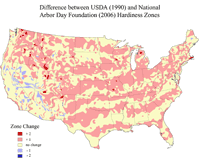Gardening in an Era of Climate Change: Is the Sky Really Falling?
by Jonah Holland, PR & Marketing Coordinator, Lewis Ginter Botanical Garden
With Lewis Ginter gearing up to host “Gardening in an Era of Climate Change: Is the Sky Really Falling?” (Feb. 4, 5, and 6), I’ve been thinking about educating myself on how much has actually changed with the climate. I’m finding some good resources. The New York Botanical Garden, like Lewis Ginter, is trying to stay at the forefront of the discussion, and according to their website, is approaching the subject from a similar standpoint:
[The New York Botanical Garden] approaches this important topic in the positive spirit of promoting dialogue on the latest thinking and scientific research about climate change.
And, just as Lewis Ginter is hosting Gardening in an Era of Climate Change, the New York Botanical Garden has hosted similar events to get people thinking. That’s what we want to do. Start discussions, hatch ideas, and find solutions. What exactly is happening and why? Is our environment drastically changing? With weather being so cyclical can we even tell? What are the solutions?
There are some very interesting projects going on. The Union of Concerned Scientists is sponsoring a project, to encourage writers and photographers to share their stories of global warming in order to inspire others to make positive changes in their lives.
Some of my background reading on gardening during an era of climate change includes learning about sustainable gardening with “garden coach” Susan Harris and of course the revised hardiness map of the United States (illustrated above), and put out by the Arbor Day Foundation in 2006.
It looks like solutions based on both adapting to the temperature changes by planting different species, that are more heat tolerant and more draught resistant is part of the solution. But the other part may lie in finding ways individuals and industry alike can reduce their impact on the environment.
One of the best written pieces on the subject is actually from The New York Times, published in 2007. It makes a moving point:
Already, some states are facing the possibility that the cherished local flora that has helped define their identities — the Ohio buckeye, the Kansas sunflower or the Mississippi magnolia — may begin to disappear within their borders and move north.
By the end of the century, the climate will no longer be favorable for the official state tree or flower in 28 states, according to “The Gardener’s Guide to Global Warming,” a report released last month by the National Wildlife Federation.
Also, the article highlights some positive trends:
Nationally, the use of products like organic fertilizer, which requires less energy to produce than conventional fertilizer — and thus results in fewer emissions of heat-trapping gases — is ballooning, with some manufacturers reporting a doubling in demand each year.
Gardening and do-it-yourself magazines have begun to popularize rain gardens, which collect rainwater in barrels or shallow basins that are part of the landscaping. And mainstream publications like Martha Stewart Living and Better Homes and Gardens have advocated cutting back on gasoline-powered lawnmowers and blowers in favor of greener machines like rechargeable or push mowers, which come in sleek new lightweight designs.
I’m really looking forward to what author, plant expert and University of Georgia professor Allan Armitage, Ph.D., will say when he presents The Heat Is On: Helping Green Industries and Gardeners Adapt in a Period of Transition. I wonder what new innovations and challenges urban horticulture specialist and award-winning author Felder Rushing will discus during Challenges Facing “Garden Variety” Gardeners and Pros Alike.
But most of all, I’m interested to see how Armitage, Rushing, and other industry leaders, including James Urban, Richard Bir, Kennon Williams, will help us turn today’s challenges into tomorrow’s opportunities.
Registration for the Gardening in an Era of Climate Change symposium opens in November.
